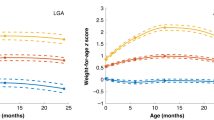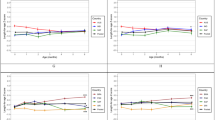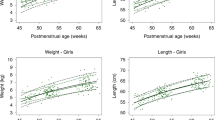Abstract
Background/Objectives:
The objective of this study was to examine the association of individually derived infant weight growth velocity patterns with general and abdominal adiposity measures in childhood.
Subjects/Methods:
In a population-based prospective cohort study among 5126 children, we used repeated growth measurements between 0 and 3 years of age to derive peak weight velocity (PWV), age at adiposity peak (AGEAP) and body mass index at adiposity peak (BMIAP). At the median age of 6.0 years (95% range 5.7, 6.8), we estimated body mass index (BMI), body fat percentage, android/gynoid fat mass ratio and pre-peritoneal abdominal fat area by using dual-energy X-ray absorptiometry and abdominal ultrasound.
Results:
Higher infant PWV and BMIAP were associated with higher childhood BMI, body fat percentage, android/gynoid fat mass ratio and pre-peritoneal abdominal fat area (all P-values<0.05), with the strongest effect estimates for BMI (differences in BMI: 0.37 standard deviation (s.d.), 95% confidence interval (CI): 0.34, 0.39 and 0.45 s.d. (95% CI: 0.43, 0.48) per 1-s.d. increase in infant PWV and BMIAP, respectively). Infant AGEAP in the highest tertile (>0.75 years) was associated with higher general and abdominal adiposity among girls at the age of 6 years (all P-values<0.05). Similarly, a 1-s.d. higher infant PWV and BMIAP were associated with increased risks of childhood overweight (odds ratios (95% CI): 2.1 (1.9, 2.3) and 2.5 (2.2, 2.8), respectively). These associations were independent of gestational age and size at birth and tended to be stronger among girls.
Conclusions:
Higher infant PWV and BMIAP are associated with adverse general and abdominal fat distribution profiles and increased risks of overweight at school age. Whether infant growth patterns add to the prediction of later overweight should be further studied.
This is a preview of subscription content, access via your institution
Access options
Subscribe to this journal
Receive 12 print issues and online access
$259.00 per year
only $21.58 per issue
Buy this article
- Purchase on Springer Link
- Instant access to full article PDF
Prices may be subject to local taxes which are calculated during checkout


Similar content being viewed by others
References
Han JC, Lawlor DA, Kimm SY . Childhood obesity. Lancet 2010; 375: 1737–1748.
Franks PW, Hanson RL, Knowler WC, Sievers ML, Bennett PH, Looker HC . Childhood obesity, other cardiovascular risk factors, and premature death. New Engl J Med 2010; 362: 485–493.
Kemp MW, Kallapur SG, Jobe AH, Newnham JP . Obesity and the developmental origins of health and disease. J Paediatr Child H 2012; 48: 86–90.
Godfrey KM, Inskip HM, Hanson MA . The long-term effects of prenatal development on growth and metabolism. Semin Reprod Med 2011; 29: 257–265.
Eriksson J, Forsen T, Tuomilehto J, Osmond C, Barker D . Size at birth, childhood growth and obesity in adult life. Int J Obes Relat Metab Disord 2001; 25: 735–740.
Ong KK, Loos RJ . Rapid infancy weight gain and subsequent obesity: systematic reviews and hopeful suggestions. Acta Paediatr 2006; 95: 904–908.
Stettler N, Zemel BS, Kumanyika S, Stallings VA . Infant weight gain and childhood overweight status in a multicenter, cohort study. Pediatrics 2002; 109: 194–199.
Mook-Kanamori DO, Durmus B, Sovio U, Hofman A, Raat H, Steegers EA et al. Fetal and infant growth and the risk of obesity during early childhood: the Generation R Study. Eur J Endocrinol 2011; 165: 623–630.
Gishti O, Gaillard R, Manniesing R, Abrahamse-Berkeveld M, van der Beek EM, Heppe DH et al. Fetal and infant growth patterns associated with total and abdominal fat distribution in school-age children. J Clin Endocrinol Metab 2014; 99: 2557–2566.
Tzoulaki I, Sovio U, Pillas D, Hartikainen AL, Pouta A, Laitinen J et al. Relation of immediate postnatal growth with obesity and related metabolic risk factors in adulthood: the northern Finland birth cohort 1966 study. Am J Epidemiol 2010; 171: 989–998.
Pischon T, Boeing H, Hoffmann K, Bergmann M, Schulze MB, Overvad K et al. General and abdominal adiposity and risk of death in Europe. New Engl J Med 2008; 359: 2105–2120.
Srinivasan SR, Wang R, Chen W, Wei CY, Xu JH, Berenson GS . Utility of waist-to-height ratio in detecting central obesity and related adverse cardiovascular risk profile among normal weight younger adults (from the Bogalusa Heart Study). Am J Cardiol 2009; 104: 721–724.
Maffeis C, Corciulo N, Livieri C, Rabbone I, Trifiro G, Falorni A et al. Waist circumference as a predictor of cardiovascular and metabolic risk factors in obese girls. Eur J Clin Nutr 2003; 57: 566–572.
Garnett SP, Baur LA, Srinivasan S, Lee JW, Cowell CT . Body mass index and waist circumference in midchildhood and adverse cardiovascular disease risk clustering in adolescence. Am J Clin Nutr 2007; 86: 549–555.
Falaschetti E, Hingorani AD, Jones A, Charakida M, Finer N, Whincup P et al. Adiposity and cardiovascular risk factors in a large contemporary population of pre-pubertal children. Eur Heart J 2010; 31: 3063–3072.
Savva SC, Tornaritis M, Savva ME, Kourides Y, Panagi A, Silikiotou N et al. Waist circumference and waist-to-height ratio are better predictors of cardiovascular disease risk factors in children than body mass index. Int J Obesity 2000; 24: 1453–1458.
Lawlor DA, Benfield L, Logue J, Tilling K, Howe LD, Fraser A et al. Association between general and central adiposity in childhood, and change in these, with cardiovascular risk factors in adolescence: prospective cohort study. BMJ 2010; 341: c6224.
Gishti O, Gaillard R, Durmus B, Abrahamse M, van der Beek EM, Hofman A et al. BMI, total and abdominal fat distribution, and cardiovascular risk factors in school-age children. Pediatr Res 2015; 77: 710–718.
Jaddoe VW, van Duijn CM, Franco OH, van der Heijden AJ, van IJzendoorn MH, de Jongste JC et al. The Generation R Study: design and cohort update 2012. Eur J Epidemiol 2012; 27: 739–756.
Kruithof CJ, Kooijman MN, van Duijn CM, Franco OH, de Jongste JC, Klaver CC et al. The Generation R Study: Biobank update 2015. Eur J Epidemiol 2014; 29: 911–927.
Niklasson A, Ericson A, Fryer JG, Karlberg J, Lawrence C, Karlberg P . An update of the Swedish Reference-Standards for weight, length and head circumference at birth for given gestational-age (1977-1981). Acta Paediatr Scand 1991; 80: 756–762.
Fredriks AM, van Buuren S, Burgmeijer RJ, Meulmeester JF, Beuker RJ, Brugman E et al. Continuing positive secular growth change in The Netherlands 1955-1997. Pediatr Res 2000; 47: 316–323.
Sovio U, Bennett AJ, Millwood IY, Molitor J, O'Reilly PF, Timpson NJ et al. Genetic determinants of height growth assessed longitudinally from infancy to adulthood in the Northern Finland Birth Cohort 1966. PLoS Genet 2009; 5: e1000409.
Cole TJ, Bellizzi MC, Flegal KM, Dietz WH . Establishing a standard definition for child overweight and obesity worldwide: international survey. BMJ 2000; 320: 1240–1243.
Kaul S, Rothney MP, Peters DM, Wacker WK, Davis CE, Shapiro MD et al. Dual-energy X-ray absorptiometry for quantification of visceral fat. Obesity (Silver Spring) 2012; 20: 1313–1318.
Suzuki R, Watanabe S, Hirai Y, Akiyama K, Nishide T, Matsushima Y et al. Abdominal wall fat index, estimated by ultrasonography, for assessment of the ratio of visceral fat to subcutaneous fat in the abdomen. Am J Med 1993; 95: 309–314.
Mook-Kanamori DO, Holzhauer S, Hollestein LM, Durmus B, Manniesing R, Koek M et al. Abdominal fat in children measured by ultrasound and computed tomography. Ultrasound Med Biol 2009; 35: 1938–1946.
Coolman M, de Groot CJ, Jaddoe VW, Hofman A, Raat H, Steegers EA . Medical record validation of maternally reported history of preeclampsia. J Clin Epidemiol 2010; 63: 932–937.
Migrants in the Netherlands, 2003: Statistics Netherlands, 2003.
Wells JC, Cole TJ . ALSPAC study steam. Adjustment of fat-free mass and fat mass for height in children aged 8 y. Int J Obesity 2002; 26: 947–952.
Sterne JA, White IR, Carlin JB, Spratt M, Royston P, Kenward MG et al. Multiple imputation for missing data in epidemiological and clinical research: potential and pitfalls. BMJ 2009; 338: b2393.
Ong KK, Ahmed ML, Emmett PM, Preece MA, Dunger DB . Association between postnatal catch-up growth and obesity in childhood: prospective cohort study. BMJ 2000; 320: 967–971.
Parsons TJ, Power C, Manor O . Fetal and early life growth and body mass index from birth to early adulthood in 1958 British cohort: longitudinal study. BMJ 2001; 323: 1331–1335.
Silverwood RJ, De Stavola BL, Cole TJ, Leon DA . BMI peak in infancy as a predictor for later BMI in the Uppsala Family Study. Int J Obes (Lond) 2009; 33: 929–937.
Sovio U, Mook-Kanamori DO, Warrington NM, Lawrence R, Briollais L, Palmer CN et al. Association between common variation at the FTO locus and changes in body mass index from infancy to late childhood: the complex nature of genetic association through growth and development. PLoS Genet 2011; 7: e1001307.
Karlberg J, Albertsson-Wikland K . Growth in full-term small-for-gestational-age infants: from birth to final height. Pediatr Res 1995; 38: 733–739.
Hediger ML, Overpeck MD, Maurer KR, Kuczmarski RJ, McGlynn A, Davis WW . Growth of infants and young children born small or large for gestational age: findings from the Third National Health and Nutrition Examination Survey. Arch Pediatr Adolesc Med 1998; 152: 1225–1231.
Ounsted MK, Moar VA, Scott A . Children of deviant birthweight at the age of seven years: health, handicap, size and developmental status. Early Hum Dev 1984; 9: 323–340.
Scott A, Moar V, Ounsted M . Growth in the first four years: I. The relative effects of gender and weight for gestational age at birth. Early Hum Dev 1982; 7: 17–28.
Taylor RW, Jones IE, Williams SM, Goulding A . Body fat percentages measured by dual-energy X-ray absorptiometry corresponding to recently recommended body mass index cutoffs for overweight and obesity in children and adolescents aged 3-18 y. Am J Clin Nutr 2002; 76: 1416–1421.
Gaillard R, Steegers EA, Tiemeier H, Hofman A, Jaddoe VW . Placental vascular dysfunction, fetal and childhood growth, and cardiovascular development: The generation R study. Circulation 2013; 128: 2202–2210.
Jensen SM, Ritz C, Ejlerskov KT, Molgaard C, Michaelsen KF . Infant BMI peak, breastfeeding, and body composition at age 3 y. Am J Clin Nutr 2015; 101: 319–325.
Wright CM, Cox KM, Sherriff A, Franco-Villoria M, Pearce MS, Adamson AJ et al. To what extent do weight gain and eating avidity during infancy predict later adiposity? Public Health Nutr 2012; 15: 656–662.
Sovio U, Kaakinen M, Tzoulaki I, Das S, Ruokonen A, Pouta A et al. How do changes in body mass index in infancy and childhood associate with cardiometabolic profile in adulthood? Findings from the Northern Finland Birth Cohort 1966 Study. Int J Obes 2014; 38: 53–59.
Wells JC, Haroun D, Levene D, Darch T, Williams JE, Fewtrell MS . Prenatal and postnatal programming of body composition in obese children and adolescents: evidence from anthropometry, DXA and the 4-component model. Int J Obes (Lond) 2011; 35: 534–540.
Bazzocchi A, Filonzi G, Ponti F, Sassi C, Salizzoni E, Battista G et al. Accuracy, Reproducibility and Repeatability of Ultrasonography in the Assessment of Abdominal Adiposity. Acad Radiol 2011; 18: 1133–1143.
Durmus B, Heppe DH, Gishti O, Manniesing R, Abrahamse-Berkeveld M, van der Beek EM et al. General and abdominal fat outcomes in school-age children associated with infant breastfeeding patterns. Am J Clin Nutr 2014; 99: 1351–1358.
Acknowledgements
The Generation R Study is conducted by the Erasmus Medical Center in close collaboration with the School of Law and Faculty of Social Sciences of the Erasmus University Rotterdam, the Municipal Health Service Rotterdam area, Rotterdam, the Rotterdam Homecare Foundation, Rotterdam, and the Stichting Trombosedienst and Artsenlaboratorium Rijnmond (STAR), Rotterdam. We gratefully acknowledge the contribution of participating mothers, general practitioners, hospitals, midwives and pharmacies in Rotterdam. The Generation R Study is financially supported by the Erasmus Medical Center, Rotterdam, the Erasmus University Rotterdam and the Netherlands Organization for Health Research and Development. Vincent Jaddoe received an additional grant from the Netherlands Organization for Health Research and Development (NWO, ZonMw-VIDI 016.136.361) and an European Research Council Consolidator Grant (ERC-2014-CoG-648916). The research leading to these results has received funding from the European Union’s Seventh Framework Programme (FP7/2007-2013), project EarlyNutrition under grant no289346. Abdominal ultrasound assessments were partially funded by an unrestricted grant from Danone Early Nutrition. CJK, OG, RG and VWVJ designed and conducted the research and wrote the paper. CJK and OG analyzed the data. AH provided comments and consultation regarding the analyses and manuscript. CJK had primary responsibility for final content. All authors gave final approval of the version to be published.
Author information
Authors and Affiliations
Corresponding author
Ethics declarations
Competing interests
The authors declare no conflict of interest.
Additional information
Supplementary Information accompanies this paper on European Journal of Clinical Nutrition website
Supplementary information
Rights and permissions
About this article
Cite this article
Kruithof, C., Gishti, O., Hofman, A. et al. Infant weight growth velocity patterns and general and abdominal adiposity in school-age children. The Generation R Study. Eur J Clin Nutr 70, 1144–1150 (2016). https://doi.org/10.1038/ejcn.2016.60
Received:
Revised:
Accepted:
Published:
Issue Date:
DOI: https://doi.org/10.1038/ejcn.2016.60
This article is cited by
-
Longitudinal association between the timing of adiposity peak and rebound and overweight at seven years of age
BMC Pediatrics (2022)
-
Maternal and infant prediction of the child BMI trajectories; studies across two generations of Northern Finland birth cohorts
International Journal of Obesity (2021)
-
Serial assessment of fat and fat-free mass accretion in very preterm infants: a randomized trial
Pediatric Research (2020)
-
Infant Growth and Long-term Cardiometabolic Health: a Review of Recent Findings
Current Nutrition Reports (2019)
-
Newborn insula gray matter volume is prospectively associated with early life adiposity gain
International Journal of Obesity (2017)



